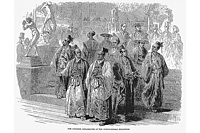Second London International Exposition of 1862
First international exposition seen by Japanese
Column: Japanese Embassy
In 1862, in a bid to negotiate the postponement of the opening of Japanese cities and ports to foreign countries, the shogunate dispatched an embassy to the United Kingdom and five other European treaty partner countries, which had forced Japan to immediately open its ports to them. Led by Yasunori Takeuchi, governor of the Shimotsuke region, the Takeuchi Embassy to Europe comprised a total of 38 members, including Yukichi Fukuzawa and Gen'ichiro Fukuchi.
The embassy arrived at London on April 30, 1862, followed by the members' attendance as official guests at the opening ceremony of the second London International Exposition on May 1. Most of the Japanese embassy members, including Yukichi Fukuzawa, appeared at the ceremony in traditional, formal Japanese attire. While their subdued colored clothes and traditional Japanese hairstyles attracted curious gazes from the public, their reserved and polite behavior was highly regarded. During their stay in the United Kingdom, they constantly drew public attention.
The Japanese embassy visited the exposition many times and observed the exhibits attentively, especially those of machinery. They also visited many facilities, such as a telegraph station, a naval shipyard, a dockyard and a firearm factory. It is known that they wrote down about the production process of the Armstrong Gun, a quick-firing gun invented in 1855. The Armstrong Gun was used in the Boshin Civil War in Japan.
Although there were no official Japanese exhibits at the London International Exposition, some Japanese industrial art products were found at the venue. This was because R. Alcock, the first British diplomatic representative to Japan, exhibited various Japanese items he had collected. He made arrangements for the embassy's dispatch to Europe and its activities in the region. His exhibits included not only industrial art products, such as lacquered japan ware and swords, but also straw raincoats, lanterns and straw sandals. While these items were highly praised by European people, they were received differently by the Japanese embassy members. Tokuzo Fuchibe, one of the members, complained in his Oko Nikki (Diary of Travel to Europe) that they had been like old bric-a-brac and that all the Japanese exhibits had been very shabby.
- See the Column: Vienna International Exposition and Japonism
The international event provided an opportunity for Western people to learn about Japanese people and industrial art products, and for Japanese people to observe Western culture. Meanwhile, it is said that Yukichi Fukuzawa, a member of the embassy, invented the Japanese word hakurankai for "exhibition" at this time.
- References:
Kyushima, Nobuaki.: 'Banpaku' hatsumei hakken 50 no monogatari (Kodansha, 2004) <D7-H45>
Nishikawa, Tomoyuki.: Wi*n no japonisumu (Zenpen) 1873 nen win bankoku hakurankai in Gengo bunka ronshu v. 27 n. 2 (2006) <Z12-503>
Suzuki, Takeo, Snowden, Paul, Zobel, Gunter.: Yoroppajin no mita bunkyu shisetsudan: Igirisu Doitsu Roshia (Waseda daigaku shuppanbu, 2005) <GB383-H27>)
Yoshida, Mitsukuni; Nihon hoso kyokai (ed).: Bankoku hakurankai: Sono rekishi to yakuwari (Nihon hoso kyokai, 1985)<D7-E82>
Yoshimi, Toshiya.: Hakurankai no seijigaku (Chuo koronsha, 1992) <D7-E89>


